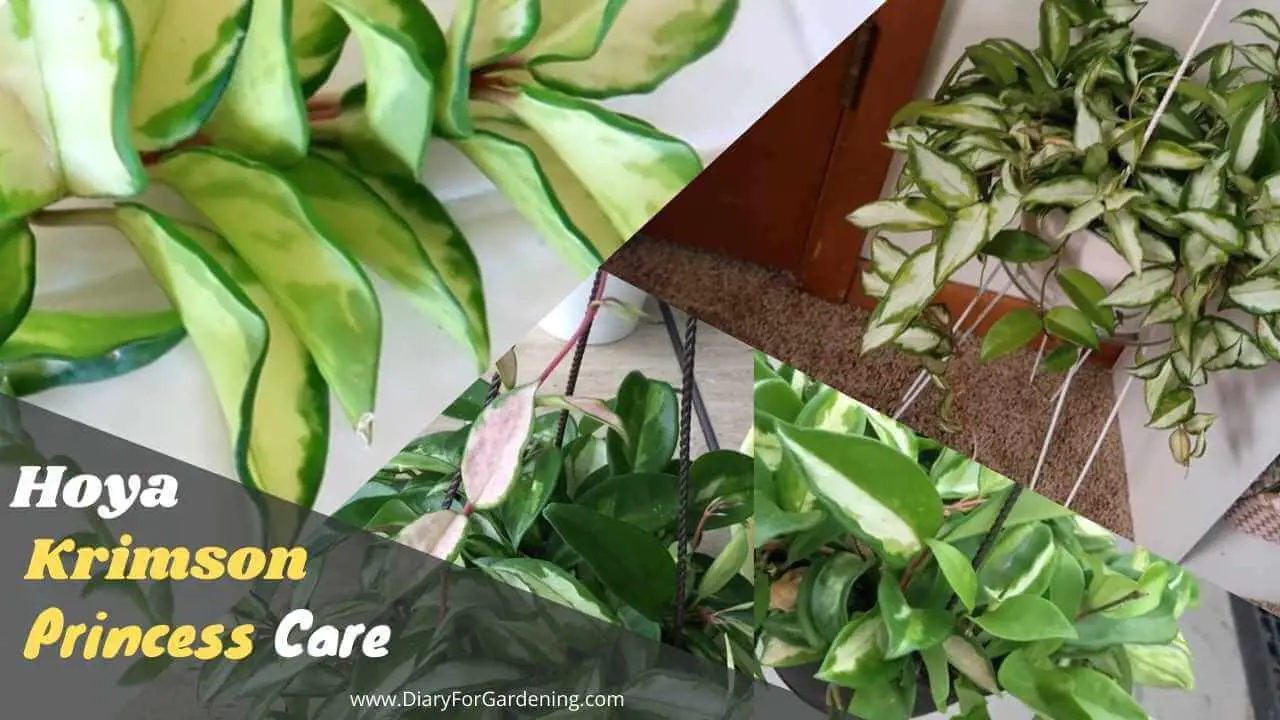Alocasia Macrorrhizos ‘giant taro’ care, propagation- All you need to know
Are you an admirer of alocasia Macrorrhizos ‘giant taro’ but don’t know how to take care of it? Then, this article is for you!
Being a plant dweller of rainforest, Alocasia Macrorrhizos performs best under partial shade conditions, providing it shelter against damage from strong winds. Organically rich, porous, moist,well-aerated soil with regular watering and fertilization are the prerequisites to have a beautiful robust giant taro. Full sunlight and waterlogging conditions may result in leaf burning and root rot simultaneously.
In this article, we tried to provide all these little but important details regarding the maintenance of Alocasia Macrorrhizos. So, scroll down and enjoy gardening!
Alocasia Macrorrhizos giant taro overview
| Scientific name | Alocasia macrorrhizos |
| Family | Araceae |
| Common name | Giant Upright Elephant Ears, Giant Taro, Giant Alocasia, Giant Elephant’s Ear |
| Origin | Native to the Philippines, also found in Malaysia, and parts of Indonesia, Queensland and the Solomon Islands |
| Plant height | 12 to 15 feet |
| Plant width | 8 feet |
| Leaf size | 3 to 4 feet |
| Plant type | Evergreen, Herbaceous perennial plant with large attractive foliage |
| Leaf appearance | glossy green leaves with prominent venation which resembles elephant’s ear in both size and shape |
| Stem | Green colored rigid stalks which jut vertically from a stout upright trunk |
| Sunlight | Bring indirect sunlight |
| Watering | once a week is sufficient |
| Soil | well-drained, humus-rich, fertile loamy soil |
| Humidity | High humidity least 60% humidity |
| Temperature | 60 to 85 degrees Fahrenheit (15 to 30 degrees Celsius) |
| Fertilizer | Heavy feeder, requires fertilization every two weeks in the growing season(spring, summer) but monthly at other times. |
Where to buy Alocasia macrorrhizos Giant Taro?
You may find alocasia macrorrhizos in the local nurseries around your region. Otherwise, you may purchase it from online plant shops or websites. For your convenience, I am mentioning ETSY where you can find healthy live Alocasia macrorrhizos giant taro.

Alocasia macrorrhizos Giant Taro plant care
Growing alocasia macrorrhizos is practically easy. But that does not mean that you won’t have to take care of it. There are certain problems that you would face if you don’t maintain your giant taro properly.
Light requirement for Alocasia macrorrhizos Giant Taro
Gaint taro grows best in a position of partial shade but is tolerant of full sun and of deep shade. But leaves scorch when exposed to full sun and low light is not preferable. Therefore place your plant where it can receive the sun’s indirect rays for a maximum period of the day.
Watering Guide for Alocasia macrorrhizos Giant Taro
Alocasia macrorrhizos is a water-loving species that needs plenty of moisture throughout the year except in cold months, as the plant goes dormant. Therefore, reduce watering in autumn or winter.
In general, watering once a week should be sufficient for the plant. But if temperatures are high and dry, you will need to water it more frequently.
Best soil for Alocasia macrorrhizos Giant Taro
Alocasia Macrorrhizos prefers a well-drained, humus-rich, fertile loam, though it is tolerant of a wide range of soil types from sands to heavy clays. The preferred soil pH range is 5.7 – 6.3.
It is recommended to use a mixture of peat moss, perlite, and orchid bark which will give the roots plenty of aeration.
Temperature requirement for Alocasia macrorrhizos Giant Taro
The ideal temperature for alocasia macrorrhizos is between 60 degrees Fahrenheit to 85 degrees Fahrenheit (15 to 30 degrees Celsius). Cold drafts and chilly winds below this temperature can be quite disastrous for the health and growth of the plant.
In summer, this plant can be placed outside but should be brought inside as soon as winter starts.
Humidity for Alocasia macrorrhizos Giant Taro
Alocasia Macrorrhizos prefers humid conditions. It is advisable to provide a moist environment with at least 60% humidity, similar to its natural habitat in tropical rainforests.
In a dry environment (a low humid condition with high temperature), mist the plant often to create humidity in the air around it otherwise leaves will start browning.
Best fertilizer for Alocasia macrorrhizos Giant Taro
Alocasia macrorrhizos is a heavy feeder and will require frequent fertilization, especially during the growing season. Both liquid and granular fertilizers can be used.
It is recommended to use a regular houseplant fertilizer every two weeks in the growing season(spring, summer) but monthly at other times.
Use the fertilizer at half the recommended ratio to prevent toxicity.
Alocasia macrorrhizos Giant Taro propagation
There are two ways to multiply your alocasia viz. from seeds and rhizome division. But between these two methods, the most effective means of Alocasia macrorrhizos propagation is through basal division.
The ideal time of propagation is between spring to early summer.
1. Rhizome division
Separation of rhizomes: Uproot the whole plant. Divide and separate those rhizomes from the main plant with the help of a sharp and sterile pruner.
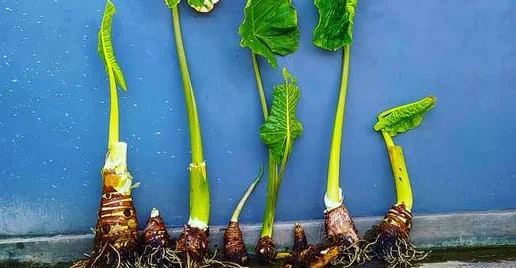
Planting the rhizome in a new pot: Plant the rhizomes individually. You can plant them directly on the ground or in the pot. In the case of indoors, place the plant in warm and indirect sunlight.
Establishment of new plant: In a couple of weeks, the plant will develop roots and establish itself well in the soil.

2. Seed propagation
Seed extraction: Extract seeds from the dried pods of the plant.
Sowing of seeds: Sow the seeds at the surface of potting mix that is slightly moist.
It can take months for the tiny seedlings to mature into a plant with huge leaves.
Repotting of alocasia macrorrhizos giant taro
Repot your alocasia annually with a new soil mix and a new pot that is only one size larger than the previous one. If you do not refresh the potting soil every year, the plant will develop more roots, but the soil will be insufficient for water retention.
The ideal time for repotting is autumn and spring.
Why is my Alocasia macrorrhizos Giant Taro crown rotting?
Crown rot is characterized by the yellowing of the leaf margins and darkened spots on the surface of the leaf. This is essentially a fungal disease that spreads from the soil all across the plant.
It can be prevented by avoiding soggy soil and overwatering.
Why is my Alocasia macrorrhizos Giant Taro having yellow leaves with brown halos?
This may be the cumulative result of several cultural practices:
- waterlogged condition
- Use of cold water
- Imbalanced fertilization
- Insufficient light
To get healthy and robust alocasia, you have to eradicate all the above-mentioned problems.
Why are my Alocasia macrorrhizos Giant Taro leaves drooping?
In most cases, giant taro plant leaves droop due to overwatering or under-watering. This may also include exposure of the plant to too little light or too much of it.
Fortunately, leaves Drooping is a common problem that can easily be fixed by Identifying the causal factor and readjusting your care routine.
Alocasia macrorrhizos Giant Taro vs Alocasia baginda ‘dragon scale’
Alocasia baginda ‘dragon scale’ is a unique variety of alocasia. It is a lovely evergreen plant with an oval shape and large silver-green foliage. A darker vein can be found near the top of the leaf; such appearance resembles the scale of a dragon, hence, its name whereas giant taro bears ruffled leaves that have a high resemblance to elephant ears.
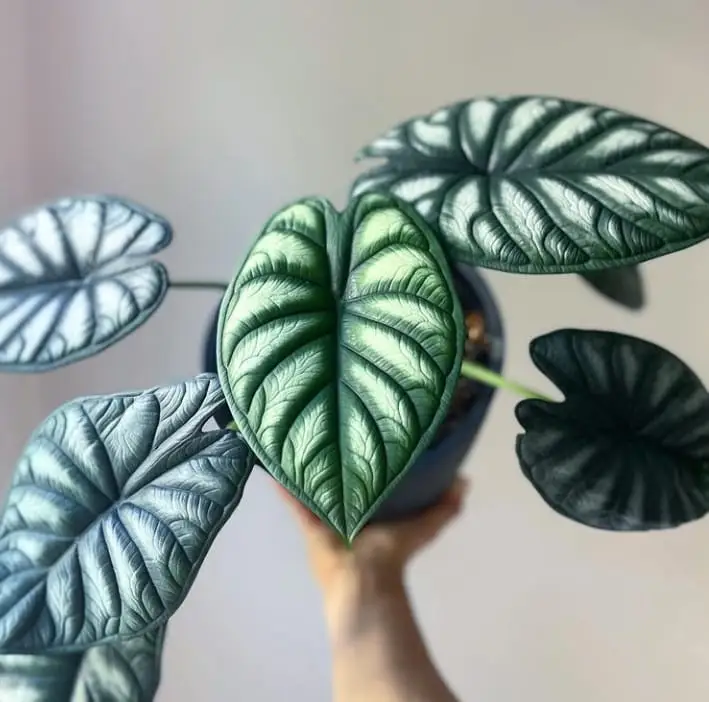
Alocasia macrorrhizos Giant Taro vs Alocasia reginula ‘Black Velvet’
Relative to Alocasia macrorrhizos, the Black velvet is way smaller in size. However, it is also known as a miniature jewel because of its attractive foliage that bears silvery-white veins.
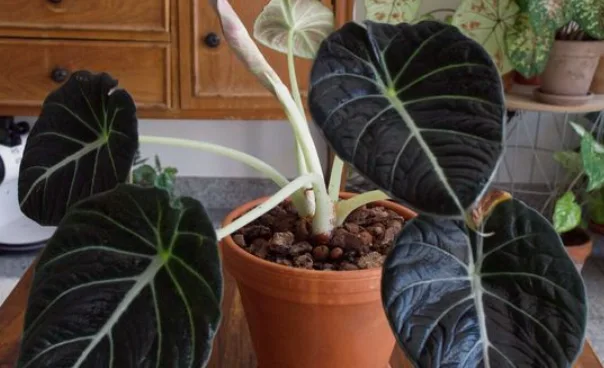
Alocasia macrorrhizos Giant Taro vs Alocasia Nebula
Alocasia macrorrhizos is a tropical evergreen plant with striking green foliage, which resembles an elephant’s ear in both size and shape. On the other hand, Alocasia Nebula has fascinating silvery gray or deep blue leaves with two lines of patterning. It has thick and exquisite type of leaves.

Is Alocasia macrorrhizos Giant Taro edible?
Yes, Alocasia macrorrhiza plant can be used for both ornamental and food crop purposes. The corm of each alocasia taro is edible. Many locals consume them as a vegetable or even as snacks like taro chips and fries.
Is Alocasia macrorrhizos Giant Taro toxic?
While the roots are edible, the other parts of giant Taro contain significant amounts of calcium oxalates that could be toxic to humans and pets. Hence, it’s important to take caution when bringing this plant indoors.
Does alocasia macrorrhizos have flower?
Alocasia macrorrhiza have yellowish-green spathe with spadix which closely resemble the flowers of Calla Lily.
This plant repeatedly blooms every few months. The flowers appear in late spring or early summer and last only for five days.
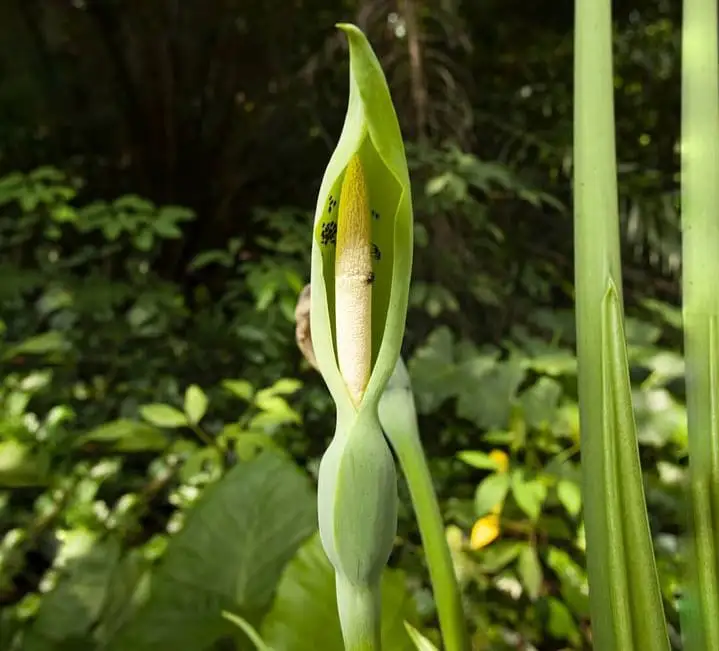
Final thoughts
Giant taro care is pretty simple and very much alike to other members of the Arum family. The techniques for proper Alocasia macrorrhiza plant care mostly depend on its growing environment. Nevertheless, it’s important to maintain the following points for the healthy growth of this species:
- Maintain a warm temperature
- plenty of water (avoid overwatering)
- Well-drained, aerated soil to prevent the rootbound condition
- dappled sunlight
For your ease, we have provided all of the details information regarding its care along with methods of multiplication. So enjoy the facts about this beautiful plant and get your giant taro right now from mentioned websites.



![Alocasia Scalprum care, propagation, leaves problem [All you need to know]](https://diaryforgardening.com/wp-content/uploads/2022/09/Alocasia-Scalprum-Care.webp)

![How to water Peace Lily while on vacation [Pro Tips]](https://diaryforgardening.com/wp-content/uploads/2022/09/Peace-lily-watering-on-vacation.webp)
